|
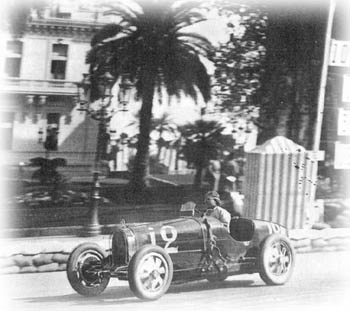 After the first European stop of the Formula One circus at Imola, it's now time for the most glamorous and most prestigious Grand Prix of all: Monaco. Originated in the mind of one Anthony Noghes, the race through the streets of the principality is one of the longest running races. From the first race in 1929, via Tazio Nuvolari's tight win over Rudolf Caracchiola in 1932 and Alberto Ascari's dive into the harbour in 1955 to Ayrton Senna's 6 wins and Mika Hakkinen's win last year, the race simply has it all. After the first European stop of the Formula One circus at Imola, it's now time for the most glamorous and most prestigious Grand Prix of all: Monaco. Originated in the mind of one Anthony Noghes, the race through the streets of the principality is one of the longest running races. From the first race in 1929, via Tazio Nuvolari's tight win over Rudolf Caracchiola in 1932 and Alberto Ascari's dive into the harbour in 1955 to Ayrton Senna's 6 wins and Mika Hakkinen's win last year, the race simply has it all.
In 1950, Monaco was one of the seven lucky venues to be included in the first Formula One season. Monaco was the second race on the calendar, after the inaugural race at Silverstone. The start of the first World Championship race set the tone for most future starts in the principality. In the first lap, when entering Tobacconist corner, Giuseppe Farina's Alfa Romeo slipped over a wave that had struck the harbour, spun and blocked most of the track. The result was a nine car pile-up around which the other drivers had to find a way.
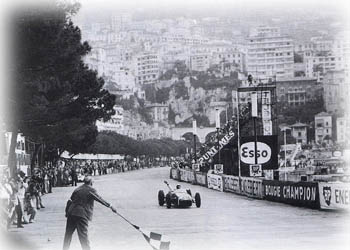 The next incident happened in the final corner of that turbulent first lap. Jose Froilan Gonzalez' Maserati caught fire at the Gasometer bend. The big Argentinean himself also caught fire, but was able to extinguish it in time. Through all the early race drama Juan Manuel Fangio escaped unharmed in his Alfa Romeo and ran to his first World Championship win. The next incident happened in the final corner of that turbulent first lap. Jose Froilan Gonzalez' Maserati caught fire at the Gasometer bend. The big Argentinean himself also caught fire, but was able to extinguish it in time. Through all the early race drama Juan Manuel Fangio escaped unharmed in his Alfa Romeo and ran to his first World Championship win.
Until 1955 Monaco did not reappear on the championship calendar. The second race boasted as much, if not more, dramatics as the first one. In qualifying, Mercedes driver Hans Hermann lost his car just before rounding the casino. He dove under the barrier, which stayed just inches clear of his head. Nevertheless, Hermann was taken away with a broken leg. In the race, Alberto Ascari made his famous dive into the harbour with his Lancia. The Italian escaped unharmed, but was killed in testing at Monza a few days later, thus ending his career prematurely.
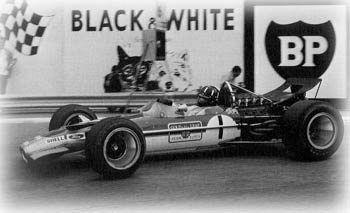 In the years following, almost all of the great drivers took their Monaco win. Almost all, except for the great Jim Clark. Despite started there from pole four times in a row, the Scotsman never managed to finish better than fourth. Where his fellow Britons Stirling Moss and Graham Hill took win after win, Clark always seemed to run into bad luck in the streets of Monte Carlo. One year Clark and his team Lotus didn't even take part in the Monaco Grand Prix; in 1965 the Indianapolis 500 was the day after Monaco and Clark proved his decision right to avoid his nemesis track in favour of an attempt to win at Indianapolis: he won the prestigious race. In the years following, almost all of the great drivers took their Monaco win. Almost all, except for the great Jim Clark. Despite started there from pole four times in a row, the Scotsman never managed to finish better than fourth. Where his fellow Britons Stirling Moss and Graham Hill took win after win, Clark always seemed to run into bad luck in the streets of Monte Carlo. One year Clark and his team Lotus didn't even take part in the Monaco Grand Prix; in 1965 the Indianapolis 500 was the day after Monaco and Clark proved his decision right to avoid his nemesis track in favour of an attempt to win at Indianapolis: he won the prestigious race.
The first ever Grand Prix with 3-liter engines was the 1966 Monaco Grand Prix. It proved to be a battle of drivers versus material, in which the latter won. Only six cars reached the finish, of which two were more than twenty laps behind winner Jackie Stewart (BRM).
In the next year a terrible accident overshadowed the race. After 82 laps, Lorenzo Bandini's Ferrari crashed in the chicane entering the harbour section. The car, and the driver stuck in it, caught fire. Bandini died a few days later of burning injuries.
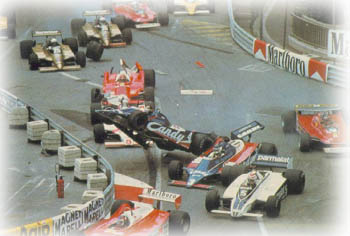 Three years later, in 1970, one of the best races ever at Monaco took place. With polesitter Jackie Stewart(Tyrrell) in the lead, chased by March driver Chris Amon and Jack Brabham in his Brabham, the race started out furious. The three didn't give each other much. On the 22nd lap Brabham was able to pass Amon. Another five laps later the lead was thrown into his lap when Stewart slowed into the pits with an engine problem. The Scotsman showed his true racing spirit by returning to the race with a crippled ignition. For another 30 laps he tried hard, but his car wasn't able to reach the finish-line after all. Three years later, in 1970, one of the best races ever at Monaco took place. With polesitter Jackie Stewart(Tyrrell) in the lead, chased by March driver Chris Amon and Jack Brabham in his Brabham, the race started out furious. The three didn't give each other much. On the 22nd lap Brabham was able to pass Amon. Another five laps later the lead was thrown into his lap when Stewart slowed into the pits with an engine problem. The Scotsman showed his true racing spirit by returning to the race with a crippled ignition. For another 30 laps he tried hard, but his car wasn't able to reach the finish-line after all.
In the mean time his place in the battle for the win was taken by McLaren driver Denis Hulme, making it a battle between two New Zealanders and an Australian. While those three fought for the win, unexpected things happened behind their backs. Austrian Lotus driver Jochen Rindt battled his way up after qualifying only eighth. While Rindt passed driver after driver, Chris Amon retired, leaving Black Jack Brabham with a semi-comfortable lead of thirteen seconds over the raging Austrian. Unfortunately the Australian slipped wide at the Gasometer bend in the final lap, just 150 meters short of victory. Rindt quickly closed the gap and took the win on his way to his first and only championship.
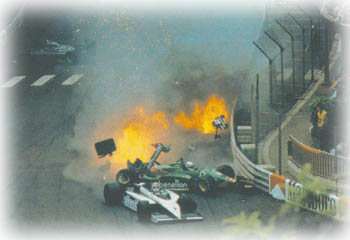 Bandini's accident and the fact that between 1955 and 1975 Ferrari didn't win in the principality, are some good indications that Monaco didn't quite suite the Italian team. In 1975 that all changed. Niki Lauda won the race from pole and repeated the act in 1976. Ferrari's wins then came in 1979 by hand of Jody Scheckter and 1981 by Gilles Villeneuve, after which another dry spell started which lasted until Michael Schumacher's win in 1997. Bandini's accident and the fact that between 1955 and 1975 Ferrari didn't win in the principality, are some good indications that Monaco didn't quite suite the Italian team. In 1975 that all changed. Niki Lauda won the race from pole and repeated the act in 1976. Ferrari's wins then came in 1979 by hand of Jody Scheckter and 1981 by Gilles Villeneuve, after which another dry spell started which lasted until Michael Schumacher's win in 1997.
Meanwhile, in 1980, another one of those famous Monaco start-line shunts had happened. Tyrrell driver Derek Daly was catapulted high above the others while breaking into Ste. Devote. When he returned to earth, he landed on top of his teammate Jean-Pierre Jarier, thus taking out the entire Tyrrell team, as well as Alain Prost's McLaren and Bruno Giacomelli's Alfa Romeo within an odd second.
Two years later the rain, often causing sensation in the normally sunny Mediterranean city, made the race a true spectacle. With the turbo Renaults of Rene Arnoux and Alain Prost respectively first and fourth on the grid, the French seemed set for a good performance. Arnoux headed straight for the lead and built a comfortable gap over his teammate who passed Brabham driver Riccardo Patrese and later Alfa's Bruno Giacomelli to catch second after seven laps.
 The Renault dream, however, didn't last long. After fifteen laps Arnoux' car spun next to the swimming pool and stalled, ending the Frenchman's race in anger. Prost then took over the lead, closely followed by Patrese, Didier Pironi's Ferrari and Giacomelli's teammate Andrea de Cesaris. The Renault dream, however, didn't last long. After fifteen laps Arnoux' car spun next to the swimming pool and stalled, ending the Frenchman's race in anger. Prost then took over the lead, closely followed by Patrese, Didier Pironi's Ferrari and Giacomelli's teammate Andrea de Cesaris.
For most of the race these four put up a tremendous show. Positions didn't change at all, but numerous attempts to pass were made in the tight and twisty streets of the principality. Then came the dreaded rain. Alain Prost was the first victim in the 73rd lap, just three short of the end. He skid out at the chicane, hitting the barriers to lose the race. Patrese then looked set for his first win, only to spin in the Loews hairpin. Pironi passed and tried to make the officials stop the race because of the bad weather circumstances. Obviously he was the only one willing to stop two laps early.
His greediness was punished right away, when his car stopped in the only dry spot to be found: the tunnel. The next in line to take victory home from the mad Monaco was Andrea de Cesaris. Sadly for him his fuel ran out on the final lap at Massenet, keeping that first victory from him - in his 208 Grand Prix career, the Italian would never come closer to winning. The laughing winner in the end became Patrese after all. Of all the crashed leaders, he was the one lucky enough to spin at the steepest downhill section of the track. After stalling the car, he was able to get it going again on the way down, just wanting to finish the race. When he passed the flag, he wasn't even sure he secured his maiden victory...
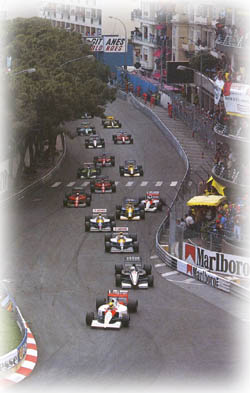 From 1984 on an amazing series started, in which just two drivers were responsible for winning the following ten races. The drivers: Alain Prost and Ayrton Senna. The cars: McLarens, all but one. 1987 proved to be the only time in the ten year period, another team managed to beat McLaren at Monaco. Ayrton Senna took his Lotus to win with a magnificent lead of 33 seconds over Nelson Piquet (Williams). In 1988, Prost took his fourth win, having won 1984 through 1986 before. After that it was just Senna. With a record five wins in a row, the Brazilian showed the track was his. From 1984 on an amazing series started, in which just two drivers were responsible for winning the following ten races. The drivers: Alain Prost and Ayrton Senna. The cars: McLarens, all but one. 1987 proved to be the only time in the ten year period, another team managed to beat McLaren at Monaco. Ayrton Senna took his Lotus to win with a magnificent lead of 33 seconds over Nelson Piquet (Williams). In 1988, Prost took his fourth win, having won 1984 through 1986 before. After that it was just Senna. With a record five wins in a row, the Brazilian showed the track was his.
That Monaco was special to him, Senna had already shown in his first race on the border of the Mediterranean sea. Back in 1984, one of the most controversial wettest ever races took place, making last year's Silverstone race looking like a mild shower with no controversy at all.
At the start, polesitter Alain Prost fired away in his McLaren, building a good lead over Nigel Mansell's Lotus. Mansell fought like a lion and caught the Frenchman after ten laps, only to spin off on the white painted road lines five laps later. Far behind the Lotus and the McLaren, two young talents first stepped into the spotlight. The young Brazilian Ayrton Senna had qualified 13th in his Toleman, but felt like a fish in the water in those terrible conditions, overtaking opponent after opponent. He was followed by a young German talent called Stefan Bellof. The Tyrrell drive raced the race of his life, coming from 20th on the grid to third in the race. Sadly his career was cut much too short, but in that amazing race in 1984 the world got to see what great potential this man had.
 The two young guns were closing in on Prost by a full second per lap when all of a sudden - 31 laps into the race - it was red flagged. Race director Jacky Ickx, a wet weather specialist in his days, was immediately accused of flagging of the race to assure Prost's win, because Prost was, like himself, in the sportscar series, powered by a Porsche engine. Much later, Senna would say that, although he was disappointed at the time, it had been a good decision to stop the race. The two young guns were closing in on Prost by a full second per lap when all of a sudden - 31 laps into the race - it was red flagged. Race director Jacky Ickx, a wet weather specialist in his days, was immediately accused of flagging of the race to assure Prost's win, because Prost was, like himself, in the sportscar series, powered by a Porsche engine. Much later, Senna would say that, although he was disappointed at the time, it had been a good decision to stop the race.
In 1994 the racing world was still in deep mourning after Senna's death two weeks earlier. After his and Roland Ratzenberger's fatal crashes at Imola, the world was shocked again when Austrian Sauber driver Karl Wendlinger crashed into the barrier coming out of the tunnel. The talented Austrian fell into a coma after having sustained severe injuries. Sauber pulled out of the race after this accident. When raceday came, the first row remained empty in tribute to Senna and Ratzenberger. Michael Schumacher scored the first of his three Monaco wins.
The German's string of success was only broken in 1996, when heavy rains decimated the field right at the start. Among those who crashed out, oddly the German rainmaster was one of the first. Eventually just four cars reached the finish-line with Olivier Panis as the surprising winner. However, in the following year Schumacher was back on top.
 The biggest surprise of the weekend came some 53 seconds behind him though: Rubens Barrichello steered his Stewart to an impressive second place, well ahead of Eddie Irvine in the second Ferrari. Jackie Stewart, the former World Champion and the then-new team owner, was crying a river, exclaiming Barrichello's podium sweeter than any of his own past-time victories of which three came in Monaco. The biggest surprise of the weekend came some 53 seconds behind him though: Rubens Barrichello steered his Stewart to an impressive second place, well ahead of Eddie Irvine in the second Ferrari. Jackie Stewart, the former World Champion and the then-new team owner, was crying a river, exclaiming Barrichello's podium sweeter than any of his own past-time victories of which three came in Monaco.
Last year will mostly be remembered for the battle between Michael Schumacher and Benetton driver Alexander Wurz. In the Loews corner, both cars touched and while going down into Portier, they clashed again while overtaking several times within ten seconds. Schumacher immediately lost his chances for the win, but continued two laps down after having his car's back replaced. Wurz was able to continue, but not without consequences. Five laps after the spectacular battle, the young Austrian emerged from the tunnel at high speed, but without any front wheels. His car came to a halt at the exact same place where fellow Austrian Wendlinger suffered his crash four years earlier.
Perhaps as odd, both the German and the Austrian drivers were in no hurry to blame the other, putting it down to sheer racing. If anything, in the current era of Formula One racing, that was refreshing.
| 







 The two young guns were closing in on Prost by a full second per lap when all of a sudden - 31 laps into the race - it was red flagged. Race director Jacky Ickx, a wet weather specialist in his days, was immediately accused of flagging of the race to assure Prost's win, because Prost was, like himself, in the sportscar series, powered by a Porsche engine. Much later, Senna would say that, although he was disappointed at the time, it had been a good decision to stop the race.
The two young guns were closing in on Prost by a full second per lap when all of a sudden - 31 laps into the race - it was red flagged. Race director Jacky Ickx, a wet weather specialist in his days, was immediately accused of flagging of the race to assure Prost's win, because Prost was, like himself, in the sportscar series, powered by a Porsche engine. Much later, Senna would say that, although he was disappointed at the time, it had been a good decision to stop the race.
 The biggest surprise of the weekend came some 53 seconds behind him though: Rubens Barrichello steered his Stewart to an impressive second place, well ahead of Eddie Irvine in the second Ferrari. Jackie Stewart, the former World Champion and the then-new team owner, was crying a river, exclaiming Barrichello's podium sweeter than any of his own past-time victories of which three came in Monaco.
The biggest surprise of the weekend came some 53 seconds behind him though: Rubens Barrichello steered his Stewart to an impressive second place, well ahead of Eddie Irvine in the second Ferrari. Jackie Stewart, the former World Champion and the then-new team owner, was crying a river, exclaiming Barrichello's podium sweeter than any of his own past-time victories of which three came in Monaco.